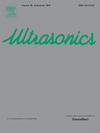A high-performance longitudinal–bending ultrasonic vibration horn: structural innovation and dynamic testing
IF 4.1
2区 物理与天体物理
Q1 ACOUSTICS
引用次数: 0
Abstract
In rotary machining, cutting tools are generally designed as axisymmetric structures to ensure dynamic balance. Traditional longitudinal–bending composite ultrasonic vibration horns with single-source excitation feature non-axisymmetric configurations due to the eccentric placement of mass blocks. Owing to the significant mass eccentricity, such horns cannot achieve dynamic balance merely by adjusting counterweight holes. As a result, these longitudinal–bending composite vibration horns are unsuitable for application in rotary ultrasonic vibration-assisted grinding (RUVAG) systems. However, various non-axisymmetric structures, such as those resembling cam-crank mechanisms, have been successfully utilized in rotary motion. These configurations achieve dynamic balance through ingenious structural designs and strategic spatial distribution. Inspired by this principle, a novel design was proposed to enable longitudinal–bending composite vibration in a non-axisymmetric horn structure, while simultaneously satisfying the dynamic balancing requirements during rotation. By integrating dynamic balancing theory with wave theory, the horn structure was mathematically modeled and optimized through finite element analysis. Experimental investigations were conducted to validate the vibration performance of the horn and to evaluate the effects of cam geometry and ultrasonic generator power on its vibration behavior. In the present study, two cam-profile horns with distinct geometric dimensions were designed and manufactured. The experimentally measured resonant frequencies were 21,640 Hz and 21,517 Hz, exhibiting relative errors of 0.478 % and 0.728 %, respectively, when compared to the simulated results. The measured longitudinal vibration amplitudes were 1.74 μm and 5.14 μm, while the corresponding bending amplitudes were 0.24 μm and 2.89 μm. The relative errors between the experimental and simulated amplitudes were 7.15 %, 8.86 %, 11.11 %, and 13.77 %, respectively. Experimental results demonstrate that the cam dimensions of the cam-profile horn significantly influence both longitudinal and bending vibration amplitudes. Specifically, increasing the cam ratio leads to enhanced vibration amplitudes. Moreover, elevating the output power of the ultrasonic generator further amplifies both modes of vibration. The proposed cam-profile horn exhibits superior vibration performance and precise amplitude controllable capability.
一种高性能纵向弯曲超声振动喇叭:结构创新与动态测试
在回转加工中,刀具一般设计成轴对称结构,以保证动平衡。传统的单源激励纵向弯曲复合超声振动喇叭由于质量块的偏心放置而具有非轴对称结构。由于质量偏心较大,单靠调整配重孔无法达到动平衡。因此,这些纵向-弯曲复合振动角不适合用于旋转超声振动辅助磨削系统。然而,各种非轴对称结构,如那些类似凸轮-曲柄机构,已成功地用于旋转运动。这些配置通过巧妙的结构设计和战略性的空间分布实现了动态平衡。受此原理的启发,提出了一种新颖的设计,使纵向弯曲复合振动在非轴对称喇叭结构中,同时满足旋转过程中的动平衡要求。将动平衡理论与波动理论相结合,对变幅杆结构进行数学建模,并通过有限元分析对其结构进行优化。通过实验研究验证了变幅喇叭的振动性能,并评估了凸轮几何形状和超声发生器功率对变幅喇叭振动性能的影响。本研究设计并制造了两个几何尺寸不同的凸轮型喇叭。实验测量的谐振频率分别为21,640 Hz和21,517 Hz,与模拟结果的相对误差分别为0.478%和0.728%。纵向振动幅值分别为1.74 μm和5.14 μm,弯曲幅值分别为0.24 μm和2.89 μm。实验振幅与模拟振幅的相对误差分别为7.15%、8.86%、11.11%和13.77%。实验结果表明,凸轮型变幅器的凸轮尺寸对其纵向和弯曲振动幅值均有显著影响。具体来说,增加凸轮比会导致振动幅值的增强。此外,提高超声波发生器的输出功率进一步放大了两种振动模式。所提出的凸轮型变幅器具有良好的振动性能和精确的幅值可控能力。
本文章由计算机程序翻译,如有差异,请以英文原文为准。
求助全文
约1分钟内获得全文
求助全文
来源期刊

Ultrasonics
医学-核医学
CiteScore
7.60
自引率
19.00%
发文量
186
审稿时长
3.9 months
期刊介绍:
Ultrasonics is the only internationally established journal which covers the entire field of ultrasound research and technology and all its many applications. Ultrasonics contains a variety of sections to keep readers fully informed and up-to-date on the whole spectrum of research and development throughout the world. Ultrasonics publishes papers of exceptional quality and of relevance to both academia and industry. Manuscripts in which ultrasonics is a central issue and not simply an incidental tool or minor issue, are welcomed.
As well as top quality original research papers and review articles by world renowned experts, Ultrasonics also regularly features short communications, a calendar of forthcoming events and special issues dedicated to topical subjects.
 求助内容:
求助内容: 应助结果提醒方式:
应助结果提醒方式:


